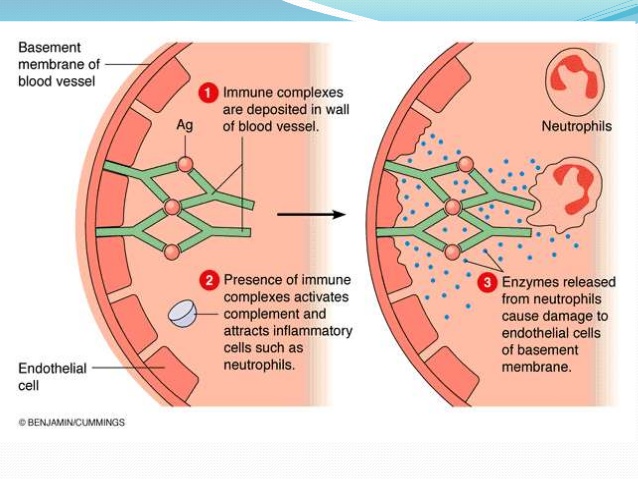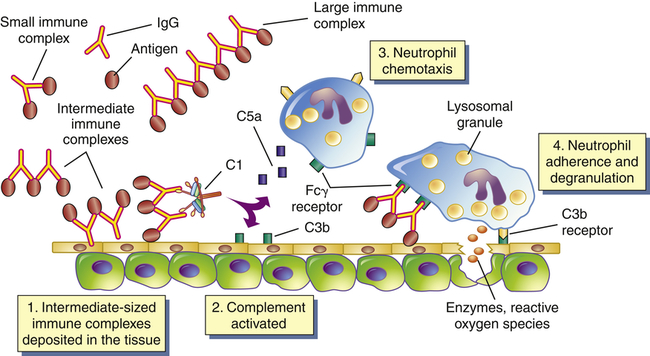
Type III hypersensitivity reaction: factors causing immune complex formation, mechanism and types
- The reaction of antibody with antigen generates immune complex. In most of the cases, these immune complexes are removed from blood circulation. Some immune complexes are removed by phagocytic action of phagocytic cells in blood. Most other immune complexes are first carried by blood to spleen where they are destroyed by macrophages. Complement system is also needed for removal of immune complexes from blood to spleen.
- In some cases large amount of immune complexes are formed and deposited on various body parts and leads to tissue damage resulting in Type III hypersensitivity reaction.
- If immune complexes are not removed from blood, they accumulate on wall of blood vessels and on tissue where filtration of blood and plasma occurs such as glomerular membrane, synovial membrane of joints etc.
- Type III hypersensitivity reaction is characterized by deposition of immune complexes on various tissues such as wall of blood vessels, glomerular basement membrane of kidney, synovial membrane of joints and choroid plexus of brain.
- Deposition of immune complexes initiates reaction resulting in damage of surrounding tissue and cause inflammation.

Factors that causes deposition of immune complex and increase susceptibility to Type III hypersensitivity reaction:
1. Persistent infection:
- In persistent infection such as Malaria, large number of immune complexes are formed and deposited in tissues.
2. Complement deficiency:
- Complement removes immune complexes from blood, but when complement system is deficient, large amount of immune complexes circulates in blood and deposits in tissues.
3. Autoimmunity:
- In autoimmune disease, large amount of immune complexes are formed and deposited in tissues.
4. Genetic defects:
- In certain genetic defects, small and soluble immune complexes are formed that can not be phagocytosed.
Mechanism of Type III hypersensitivity reaction:

- Type III hypersensitivity reaction develops when immune complex activates C3a and C5a components of complement system.
- C3a and C5a are lymphotoxin (anaphylotoxin) that causes localized mast cell degranulation.
- Degranulation of mast cell releases histamine which increases vascular permeability of blood capillaries. This facilitates deposition of immune complexes on wall of blood vessel.
- C5a, C3a and C5b67 also acts as chemotatic factors for neutrophils, So it attracts neutrophils at the site of immune complex deposition.
- C3b acts as opsonin by binding with immune complex. Neutrophil binds to C3b coated immune complex by means of type I complement receptor which is specific for C3b.
- The neutrophils attempt to phagocytose the immune complex but phagocytosis is not possible because immune complexes are deposited on basement membrane, so the neutrophil releases lytic enzymes to destroy immune complex.
- The lytic enzymes cause tissue damage surrounding of immune complex deposits, resulting hypersensitivity reaction. Furthermore complement proteins can also contribute to tissue destruction.
Types of Type III hypersensitivity reaction:
1. Localized Type III hypersensitivity reaction:
- Acute Arthus reaction is an example of localized Type III hypersensitivity reaction.
- When antigen is injected or enters intradermally or subcutaneously, they bind with antibody to form localized immune complexes which mediate acute Arthus reaction within 4 to 8 hours.
- As the reaction develops, localized tissue damage and vascular damage results in accumulation of fluids (edema) and RBCs (erythema) at the site of antigen entry.
- The severity of reaction can vary from mild swelling and redness to tissue necrosis.
2. Generalized Type III hypersensitivity reaction:
- Serum sickness is an example of generalized Type III hypersensitivity reaction.
- When large amount of antigen enter blood stream and bind to antibody, circulating immune complexes forms. If antigens are in significantly excess compared to antibody, the immune complexes formed are smaller and soluble which are not phagocytosed by phagocytic cells leading to Type III hypersensitivity reaction.
- The manifestation of serum sickness depends on the quantity of immune complex as well as overall site of deposition. The site may vary but accumulation of complexes occurs at site of blood filtration.
- Generalized Type III hypersensitivity reaction at different site results in different diseases such as Glomerulonephritis (Kideny), vasculitis (arteries), Arthritis (synovial joints).
